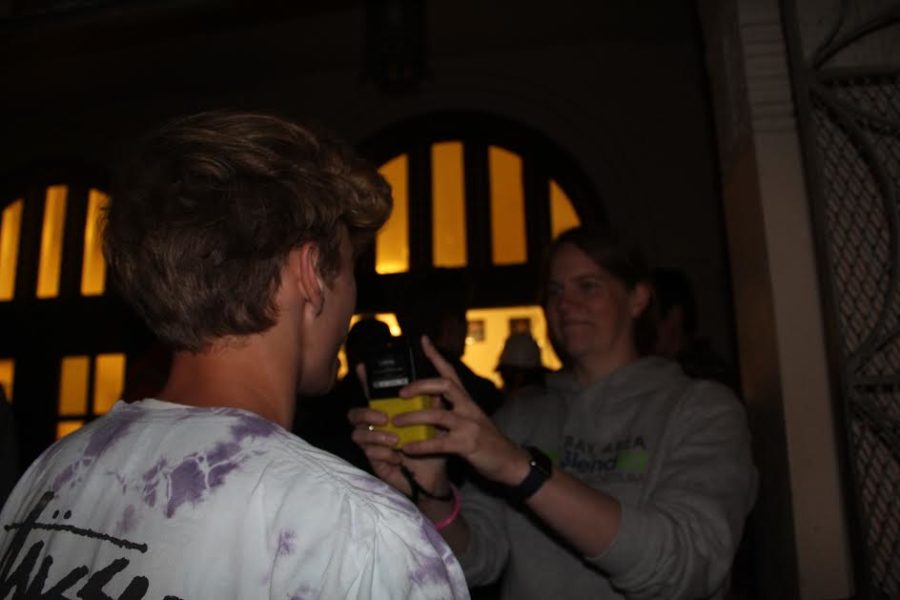The test you don’t want to blow
Before entering the Fall Dance at the Urban School, excitement surrounded the students as they took photos, painted sparkles on their face, and prepared for the space-rave-themed dance, all while waiting in line to be breathalyzed by an Urban faculty member.
Since 2011, Urban has required every student to be breathalyzed before entering dances. With the Fall Dance on September 22, the topic continues to spark conversations among students about the breathalyzer’s necessity or lack thereof.
The breathalyzer was initially implemented in November 2011, after the fall dance, to eliminate biases and ensure all students would be treated fairly. According to the handbook, “[Urban] emphasizes the importance of personal integrity and (tries) not to create situations that encourage students to ‘get away with bad behavior’ or adults to ‘play cat and mouse’.”
Some other private high schools in the Bay Area have also implemented the use of breathalyzers, such as Saint Ignatius College Preparatory, and Marin Academy, while others continue to host events breathalyzer free. Lick-Wilmerding High School, a private school in San Francisco, conducts random and suspicion-based drug and alcohol testing. At their dances and events, every third student is breathalyzed. University High School, another private school in San Francisco, just implemented a breathalyzer policy this year.
Charlotte Worsley, Assistant Head of Student Life, has been working at Urban since before the breathalyzing era and said, “For the longest time we did not breathalyze because we absolutely believe that you are innocent and assume best intent, and breathalyzing felt a little bit like we were saying everyone was bad.” However, Worsley noted that this led to more suspicions. She said, “ When you don’t breathalyze, you spend all your time checking someone’s breath.” Worsley continued, “If the goal is the [most] respect possible [for students], we thought for the longest time that that meant not breathalyzing. And then it became clear, no, it actually means breathalyzing because then you are treating everyone equally, and you are not making any assumptions.”
Indy Albani-Bombard (‘19) disagreed with the notion of the policy creating an equal playing field. “It assumes the worse in students… it’s an encroachment on our general rights,” said Albani-Bombard. “It is only sufficient in discouraging alcohol consumption, but there are other illegal substances that people can use and engage in,” he continued.
Although Albani-Bombard felt that it is an encroachment on his general rights, legally it is not. Some high schools have seen students take legal action against the breathalyzer rule. In June 2012, six months after Urban started breathalyzing, two girls from a public high school in New Jersey claimed that the mandatory breathalyzer violated their Fourth and Fifth Amendment rights. The case went to the Supreme Court which ruled that the “search was reasonable because students’ privacy had to be weighed against the school’s responsibility to maintain discipline on school grounds.” Whether it is a public school or a private school like Urban, it is legal for the school to breathalyze students because the school’s need to maintain discipline outweighs student’s right to privacy.
However, some students expressed concerns outside of the legal issues. When the breathalyzer policy was first instituted in 2011, students made similar sentiments to Albani-Bombard.
“I disagree with the breathalyzer policy because I believe it will encourage students to experiment with other drugs. Having a breathalyzer only addresses alcohol,” said Roberto Quadra a junior at the time (’12) in an Urban Legend article.
Lydia Sears (‘18) agreed that although breathalyzing prevents people from using alcohol…people have done harder drugs and that is something dangerous about the breathalyzer.” Sears said, “people do come high to the dances.”
Shafia Zaloom, one of Urban’s Health Education teachers, addressed the issue raised by Sears and several other students. When asked about students using other substances that cannot be caught with a breathalyzer, Zaloom said, “we know it happens and we try to prevent it because we are trying to maintain an environment free of illegal substances. We have to do that. We are adults that run a school and community, so we are charged with keeping kids safe.”
One of the primary concerns around the limitations of the breathalyzer is that marijuana can go under the radar. Since there is no breathalyzer-like technology for marijuana, Worsley mentioned that “in some ways we are kind of back to where we were, having to be suspicious of people,” regarding students using other illegal substances. On September 19th, 2017, Worsley made an announcement to the entire student body regarding the use of marijuana at the fall dance. “If anyone is caught with marijuana/edibles, they will be suspended. If you bring them and share them that’s distributing and could lead to expulsion,” said Worsley.
According to Worsley, the Fall Dance “seemed like a clean dance,” but she hopes no one comes forward with evidence to the contrary.
The Urban breathalyzer policy will continue at future Urban events and prom in the spring, however, the question of whether students will be further drug tested or searched continues to be unknown.












